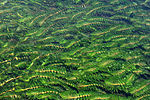Monocotyledons (/ˌmɒnəˌkɒtəˈliːdənz/), commonly referred to as monocots, (Lilianae sensu Chase & Reveal) are grass and grass-like flowering plants (angiosperms)...
116 KB (11,202 words) - 04:27, 21 December 2024
The monocots (or monocotyledons) are one of the two major groups of flowering plants (or Angiosperms), the other being the dicots (or dicotyledons). In...
27 KB (3,151 words) - 03:19, 6 January 2025
This page's list covers the monocotyledon plants found in Great Britain and Ireland. This clade includes grasses, lilies, orchids, irises and a wide variety...
36 KB (46 words) - 13:21, 6 July 2023
Monocotyledon species found in Montana number at least 615. The Montana Natural Heritage Program has identified a number of monocot species as Species...
46 KB (3,668 words) - 18:25, 23 March 2024
pseudopetiole, a petiole like structure. Pseudopetioles occur in some monocotyledons including bananas, palms and bamboos. Stipules may be conspicuous (e...
113 KB (11,787 words) - 08:43, 18 January 2025
the seed leaves, attached to the embryonic axis. There may be one (Monocotyledons), or two (Dicotyledons). The cotyledons are also the source of nutrients...
76 KB (9,452 words) - 19:46, 26 November 2024
the traditional sense) are paraphyletic because the group excludes monocotyledons. "Dicotyledon" has not been used as a botanic classification for decades...
38 KB (3,780 words) - 15:52, 10 January 2025
ISBN 971-22-0130-9, ISBN 978-971-22-0130-1 "Cyperus iria L. - CYPERACEAE - Monocotyledon". Archived from the original on 2011-07-27. Retrieved 2009-11-17. Cyperus...
2 KB (138 words) - 01:07, 19 January 2024
modern meaning of all the flowering plants including Dicotyledons and Monocotyledons. The APG system treats the flowering plants as an unranked clade without...
80 KB (6,271 words) - 16:54, 17 January 2025
Dicotyledon (section Comparison with monocotyledons)
within this group. The other group of flowering plants were called monocotyledons (or monocots), typically each having one cotyledon. Historically, these...
14 KB (784 words) - 08:32, 22 September 2024
assigned the order to the subclass Arecidae in the class Liliopsida (= monocotyledons). The Thorne system (1992) and the Dahlgren system assigned the order...
4 KB (411 words) - 03:54, 25 November 2024
aerial portions of the plant. The cotyledon of grasses and many other monocotyledons is a highly modified leaf composed of a scutellum and a coleoptile....
13 KB (1,315 words) - 06:56, 3 December 2024
The Poales are a large order of flowering plants in the monocotyledons, and includes families of plants such as the grasses, bromeliads, rushes and sedges...
13 KB (1,200 words) - 21:47, 22 November 2024
from the original on 6 November 2022. Retrieved 6 May 2022. herbaceous monocotyledons lack cambial secondary growth but may have tough leaves and hard, fibrous...
124 KB (12,862 words) - 12:25, 26 December 2024
called skotomorphogenesis, which contrasts photomorphogenesis. Epicotyl Monocotyledon Dicotyledon "hypocotyl". Oxford English Dictionary (Online ed.). Oxford...
3 KB (433 words) - 05:06, 21 February 2023
Extinct in the wild (EW): 45 species Critically endangered (CR): 5,702 species Endangered (EN): 10,901 species Vulnerable (VU): 9,673 species ...
12 KB (948 words) - 07:28, 22 May 2024
at times, grows much faster.[clarification needed] Despite being a monocotyledon, it has annual growth rings. There is considerable genetic variation...
15 KB (1,466 words) - 08:42, 3 January 2025
treated this as one of six subclasses within the class Liliopsida (=monocotyledons). It consisted of the following:[citation needed] subclass Commelinidae...
10 KB (829 words) - 14:10, 18 December 2024
the non-reproductive part of the flower called the perianth, and in monocotyledons, may not be differentiated. If this is the case, then they are described...
105 KB (11,770 words) - 22:12, 27 December 2024
Gonystylus, Ramin Ulmaceae (Elm family) Ulmus, Elm Zelkova, Zelkova About 10 Monocotyledon families include trees. Asparagaceae (Asparagus family) Cordyline, Cabbage...
11 KB (705 words) - 01:08, 8 November 2024
The Streptopoideae are a subfamily of monocotyledon perennial, herbaceous, mainly bulbous shade dwelling flowering plants in the lily family, Liliaceae...
1 KB (56 words) - 17:58, 4 July 2024
climbing flowering plants, many of which are woody and/or thorny, in the monocotyledon family Smilacaceae, native throughout the tropical and subtropical regions...
27 KB (2,504 words) - 09:10, 11 January 2025
distally ascending, reflexed (folded back), or lanceolate. Like many monocotyledons, the perianth is homochlamydeous, which is undifferentiated into separate...
255 KB (23,812 words) - 21:34, 16 January 2025
Nicholas P. (2013). "In time and with water...the systematics of alismatid monocotyledons". In Paul Wilkins and Simon J. Mayo (ed.). Early Events in Monocot Evolution...
2 KB (144 words) - 01:24, 8 April 2024
Urs; Nyffeler, R. (eds.). Illustrated Handbook of Succulent Plants: Monocotyledons (2nd ed.). Berlin: Springer-Verlag GmbH. pp. 1353–1385. Henley, R.W...
15 KB (1,444 words) - 21:47, 20 November 2024
plant taxonomists have also used the rank of subphylum, for instance monocotyledons as a subphylum of phylum Angiospermae and vertebrates as a subphylum...
2 KB (181 words) - 09:17, 9 October 2024
or from the hypocotyl rather than from the radicle of a germinating monocotyledon. adventive Introduced accidentally (usually referring to a weed). aerial...
347 KB (29,367 words) - 05:02, 11 January 2025
Self-incompatibility: genetic mechanisms which prevent self-fertilization Reproduction Monocotyledon reproduction Grossenbacher D, Briscoe Runquist R, Goldberg EE, Brandvain...
14 KB (1,933 words) - 22:17, 20 December 2024
Retrieved 27 July 2015. Klaus Kubitzki (Editor) Flowering Plants. Monocotyledons: Lilianae (except Orchidaceae), p. 305, at Google Books Michael Hickey...
9 KB (872 words) - 16:37, 10 July 2024
Humphries, C.J., eds. (1995), Monocotyledons: systematics and evolution (Proceedings of the International Symposium on Monocotyledons: Systematics and Evolution...
91 KB (8,490 words) - 01:13, 9 January 2025



























